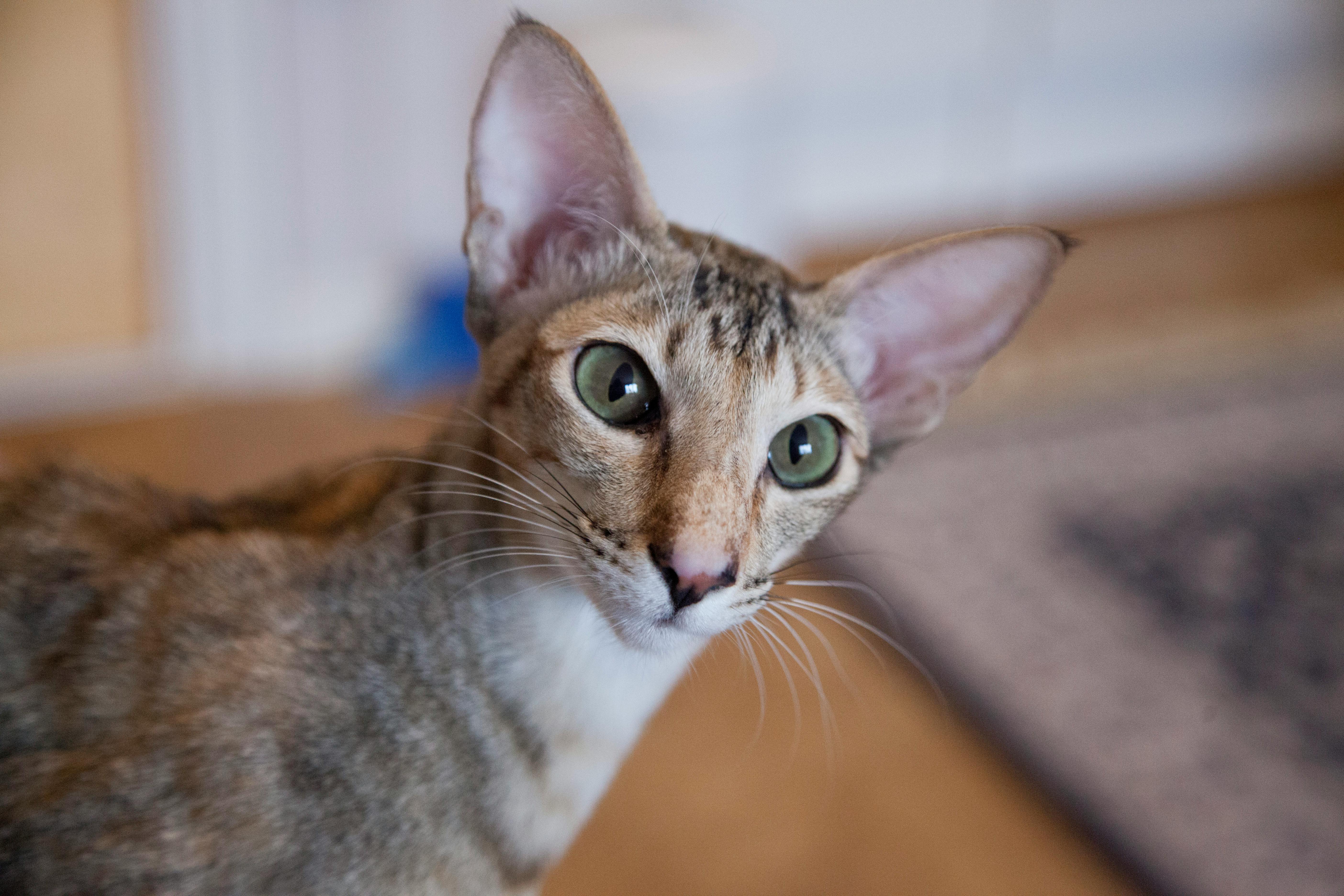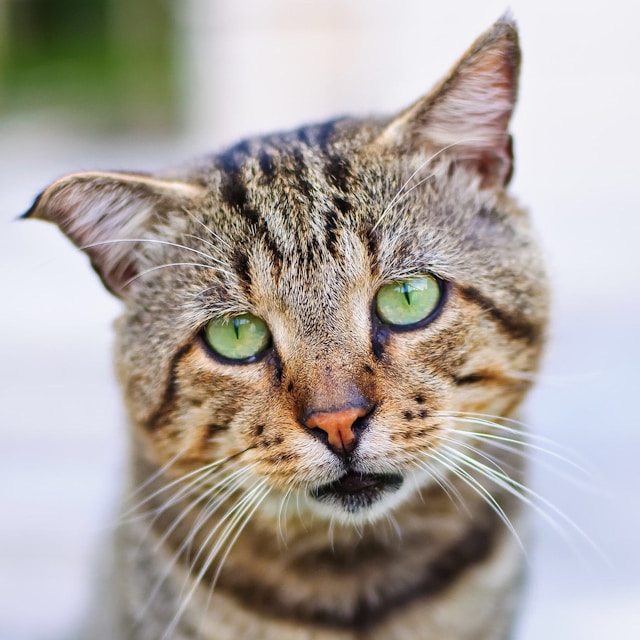Oriental Shorthair

| OFFICIAL NAME | Oriental Shorthair |
| COMMON NAME | Oriental Shorthair |
| PET HEIGHT | 9 to 11 inches |
| PET WEIGHT | 8 to 12 pounds |
| LIFESPAN | 12 to 15 years |
| GOOD WITH | cats, children, dogs, families |
| TEMPERAMENT | affectionate, sociable |
| INTELLIGENCE | high |
| SHEDDING AMOUNT | normal |
| PLAYFULNESS | high |
| ENERGY LEVEL | active |
| VOCAL LEVEL | frequent |
| COAT LENGTH | short |
| COLORS | black/ebony, blue/ gray, chocolate/brown sable, cinnamon, cream/beige/tan, fawn, lavender/ silver, lilac, red/orange, white |
| OTHER TRAITS | easy to groom, friendly toward humans, friendly toward other pets, friendly toward strangers, strong loyalty tendencies |
With their distinctive appearance—large ears, angular faces, and sleek, slender bodies—they might seem aloof at first glance, but they're quite affectionate and love being around their human companions.
Tina Gonzalez, who proudly owns several Oriental shorthairs that have gained popularity on platforms like YouTube and Instagram, shares her experience living with them. According to her, these cats enjoy being carried around the house, snuggling in laps, and even sharing the bed—often preferring to sleep under the covers.
Their short coats make grooming easier compared to their longhaired counterparts, and they tend to have a longer lifespan, often living beyond 15 years. Despite their striking looks, Oriental shorthairs are not as rare as some exotic breeds, and while you might find them available for adoption, getting one from a reputable breeder is typically the more common route.
Appearance
The Oriental shorthair might be classified as a medium-sized cat, typically weighing between 8 and 12 pounds, but its slender build gives it a much taller and graceful appearance, hinting at its ancestral ties.
According to Teresa Keiger from the Cat Fanciers' Association, if you observe closely, you'll notice that their body structure resembles that of Siamese cats. However, what sets them apart is their remarkable variety in color and patterns. Oriental shorthairs display a wide spectrum of hues ranging from blue and lavender to ebony, and their coat can feature intricate patterns like tortoiseshell and smoke. Their short, sleek coat shines beautifully when groomed regularly. While they aren't completely hypoallergenic, some allergy sufferers find that Oriental shorthairs cause fewer sneezes and sniffles compared to other breeds.
Beyond their coat, Oriental shorthairs are known for their striking facial features. Their wedge-shaped heads create a distinctive arrangement of facial characteristics, including a long nose, almond-shaped eyes, and prominent cheekbones. Perched atop their head are large, upright ears that might remind you of a Chihuahua or even Dobby, the house elf from Harry Potter. This unique combination of elegance and charm makes the Oriental shorthair a breed with an unforgettable presence.
Personality
Interested in a chat? Oriental Shorthair cats are known for their talkative nature, often emitting a unique honking sound when they want attention or are curious about what you're up to. They're highly social creatures, intelligent and affectionate, thriving in the company of their human families and other pets, especially other cats. These "Velcro kitties" have a habit of sticking close to their owners, often becoming like a second shadow, following them around the house.
Although they're not typically the type to lounge on your lap all day, they enjoy occasional cuddle sessions and are always ready for some active play. They strike a balance between being affectionate and being on the move.
Living Needs
Oriental shorthair cats thrive whether they live in houses or apartments. They have specific needs that match their social nature and high activity levels. Oriental shorthairs always prefer to have a companion nearby and enjoy playing and exploring. That's why experts recommend getting them a feline friend: "It's best to have more than one! They dislike being alone, so be prepared to dedicate your free time to their playfulness and needs. They require constant stimulation and playtime."
While a bustling household can provide the excitement these curious cats crave, it may not be ideal if you're often away for long periods. Oriental shorthairs can feel lonely easily! On the other hand, if you prefer a quieter environment at home, their energetic meows and cheerful chatter might be a bit too lively for your taste.
Known for their friendly nature, Oriental shorthairs get along well with dogs and children. However, it's important to supervise interactions with smaller kids and teach them how to engage with pets properly.
Care
Oriental shorthair cats are often more popular than their longhair counterparts because they have coats that are easier to maintain. Regular brushing enhances their sleek fur and helps reduce shedding, which occurs throughout the year. Occasionally, bathing or wiping them down further enhances their coat's appearance.
Interestingly, their short fur isn't the main grooming concern; it's their large ears. Weekly checks for wax buildup or any unusual signs are important. Your vet can guide you on the best methods for cleaning their ears, typically involving warm water on a cotton ball to gently swab them clean.
Like all cats, regular nail trimming is essential (if you hear their nails clicking on the floor, they're too long), and keeping their litter box clean is a must. Regular vet check-ups are also crucial for maintaining their overall health.
Engaging in regular play sessions with interactive toys helps fulfill an Oriental shorthair's natural curiosity and prevents boredom. These cats are highly intelligent and benefit from activities that stimulate both their minds and bodies. Spending quality playtime together also strengthens the bond between you and your cat, often leading to cozy cuddle sessions afterward.
Health
The average lifespan of an Oriental Shorthair ranges from 12 to 15 years, though some can live even longer. Like many cat breeds, they are prone to certain health concerns.
Similar to Abyssinians, Siamese, and Balinese breeds, Oriental Shorthairs can develop Amyloidosis, a serious condition in which abnormal protein deposits in tissues and organs can lead to organ failure or death. Symptoms typically appear before the age of 5 and may be inherited, but there are no reliable noninvasive or genetic tests available for detection yet.
Another inherited condition in Oriental Shorthairs is progressive retinal atrophy, which causes gradual vision loss leading to blindness. Cats with this condition usually show signs starting around seven months old and lose their sight completely between three and five years old. While genetic testing exists, unfortunately, no treatment is available.
Obesity and dental issues are common concerns for Oriental Shorthairs. Regular exercise, limiting treats, brushing their teeth, and scheduling regular dental check-ups with your vet can greatly contribute to keeping your cat healthy and happy throughout their life.
Exercise Requirements
Owning a cat has its perks, like how they often keep themselves active. Orientals, in particular, are known for their playful and energetic nature, which means they usually find ways to exercise. It's important to give your cat a cat tree and toys to help them stay engaged and avoid getting into trouble.
Training
Because Oriental Bicolor cats are highly intelligent, you might expect them to be easy to train. However, they have strong independent streaks. They generally take well to litter box training and can learn other behaviors, too, but it often requires persistent effort.
History
Imagine these elegant, majestic cats lounging with Cleopatra, but the Oriental shorthair is actually a relatively recent breed. It emerged in the 1950s when British breeders began crossing Siamese cats with other domestic breeds due to a decline in pure Siamese after World War II.
According to the CFA Oriental Breed Council, the first Oriental shorthairs are believed to have descended from black hybrids—cats with Siamese and non-Siamese ancestry—and Russian Blues. Siamese cats were further crossed with various breeds, resulting in a fascinating array of colors and patterns, each initially considered its own distinct breed. Eventually, these diverse variations were consolidated into the single breed known today as the Oriental shorthair.
Although they didn't arrive in the United States until the 1970s, Oriental shorthairs quickly gained popularity. By 1977, the Cat Fanciers' Association officially recognized them, solidifying their place in the world of pedigree cats.
Fun Facts
Gonzalez's Oriental shorthair cat, Stache, became incredibly popular online because people noticed he looks a lot like Adam Driver, the actor from Star Wars. Stache, along with his brothers Bindi, Teddy, and Dexter, are the stars of the viral hobbikats accounts on YouTube and Instagram.
Most Oriental shorthair cats have green eyes, except those with white fur.
Some Oriental shorthairs can also change their coat color. Exposure to sunlight can bring out rusty patches in black and blue cats or pale yellow patches in brown and cinnamon varieties.
There are more than 300 different colors and combinations that Oriental shorthair coats can come in.
Get insurance plans with wide-ranging coverage options













